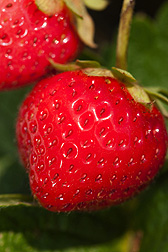Washington, DC, USA
December 23, 2014

Using a new test, ARS scientists have determined that strawberries contain higher levels of healthful compounds known as “phenolics” than previously thought.
U.S. Department of Agriculture (USDA) scientists have devised a new analytical method for detecting and measuring concentrations of phytochemicals called "polyphenols" in plant materials. Also referred to as "phenolics," the class of health-promoting compounds is found in certain foods and beverages. Agricultural Research Service (ARS) investigators have a long history of designing and developing reliable analytical methods for measuring nutrients and other compounds in foods. ARS is USDA's chief intramural scientific research agency.
At the ARS Eastern Regional Research Center (ERRC) in Wyndmoor, Pennsylvania, scientists first reported on the new test and used it on a variety of samples of beverages, grains and flaxseed. They used the new laboratory method to measure the amount of phenolics in various food samples by mixing them with Fast Blue BB diazonium salt. Under alkaline conditions, diazonium salt specifically couples with phenolics to form stable complexes that can be directly measured. The team then compared the new Fast Blue BB method to results using a traditional assay called Folin-Ciocalteu (FC). The results suggested that FC does not assess all phenolics present during tests and inadvertently measures other compounds besides phenolics.
While the Fast Blue BB method, as originally developed at the ERRC, was aimed at measuring phenolics only in plant tissue that does not contain chlorophyll, other ARS researchers reasoned that the test should also work with green vegetables if the test is modified.
ARS plant physiologist and national program leader Gene Lester led another study in which he and colleagues modified the Fast Blue BB assay so that it could be used to test green plant material. The scientists used the modified method to gauge the amount of total phenolics in different spinach cultivars grown under different production conditions. They showed that the Fast Blue BB can now be used universally to accurately assess total phenolics for all fruit and vegetable plant tissues. The study was published in the Journal of Agricultural and Food Chemistry in 2013.
Read more about this work in the November/December 2014 issue of Agricultural Research magazine.